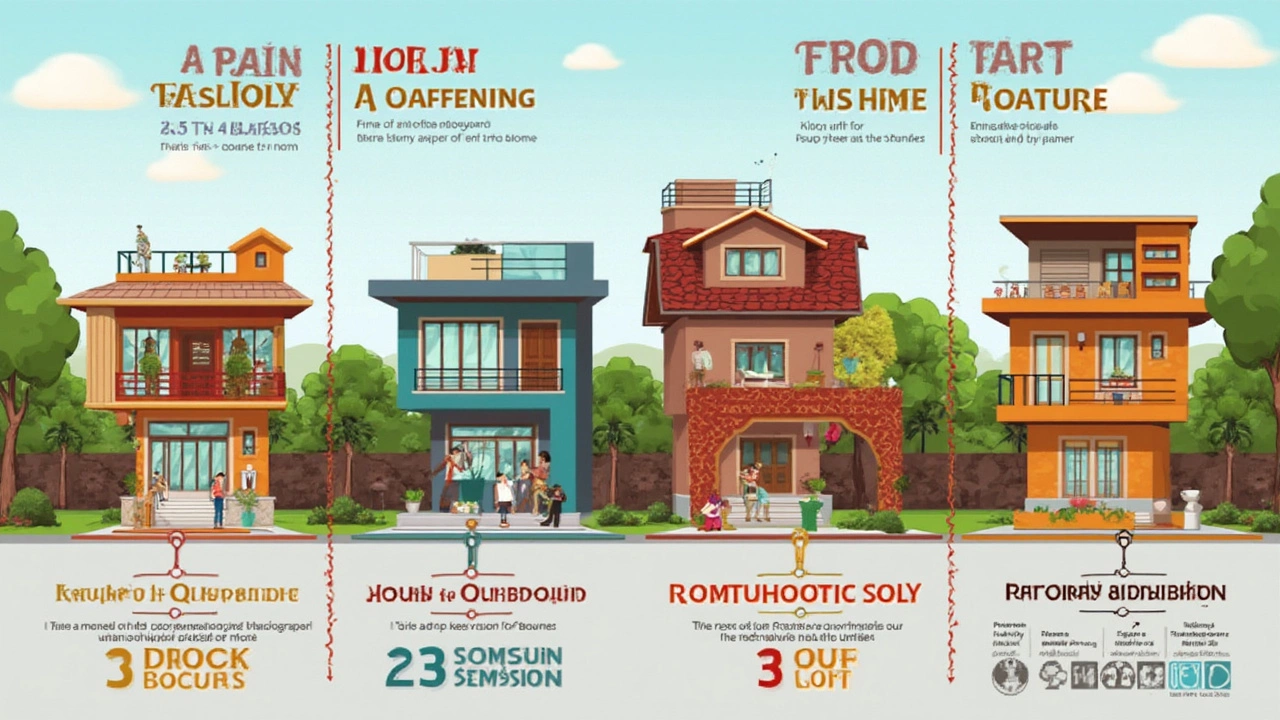Why settle for squeezing into a cramped living room or dodging boxes in the hallway? When your house feels too small for your needs, extending it is often way smarter (and cheaper) than moving. But not all extensions make sense for every home, family, or budget. Picking the right type is key—mess this up and you could end up spending more than you planned or adding a room that just doesn’t fit how you live.
Some folks want an open kitchen for massive Sunday breakfasts, others dream about an extra bedroom, and a surprising number of people just want more space for their sneaker collection. The thing is, every type of extension—from a simple lean-to to a full double-story—has its own quirks, price range, and planning hassles. Knowing the main options and what they actually bring to the table (literally) will save you from a world of headaches later.
- Different Types of House Extensions
- Cost and Value: What to Expect
- Matching Extensions to Your Lifestyle
- Tips for a Smooth Extension Project
Different Types of House Extensions
Every house and family needs something a bit different, which is why picking the right house extension is so important. Here’s a straight-up rundown of the most popular types, how they work, and when they tend to make the most sense.
- Single-story extensions: This is the go-to for a lot of people and usually gets slapped on the back or side of your place. Perfect if you want to open up your kitchen or living room and don’t need another level. Single-story add-ons typically cost less than going up, but you’ll need enough yard space so you’re not swallowing the whole garden.
- Double-story extensions: Dreaming of real space for a growing family, office, or maybe even a games room? Double-story extensions give you tons of room. Just remember, they mean more cash upfront and stricter planning rules. People often add two bedrooms and a bathroom upstairs to really get their money’s worth.
- Loft conversions: If your attic is collecting dust, don’t sleep on converting it. It’s great for another bedroom or a home office. Usually, you won’t lose any garden, and it’s faster to build since you’re staying inside your current roof. Loft conversions can boost your home’s value by up to 20% according to recent data from Zoopla.
- Garage conversions: Let’s face it—most of us don’t use the garage for cars. Turning this space into a bedroom, small studio, or home gym often doesn’t require planning permission. The structure’s already there, so it’s a budget-friendly home addition.
- Wrap-around extensions: If you have a corner property or odd-shaped lot, a wrap-around extension combines side and rear builds, making the layout way more flexible. It helps you open up rooms, let in light, or even add little nooks for hobbies or storage. This one’s a big project, but it can change the whole vibe of your house.
"Extensions are most successful when they feel like a natural part of the existing house, rather than an obvious add-on,” says architect Amanda Baillieu. “Think about flow—not just floor space."
Below you’ll find a quick cheat sheet that shows the main benefits and some extras you should keep in mind:
| Extension Type | Main Benefit | Things to Watch |
|---|---|---|
| Single-story | Cost-effective; perfect for open spaces | Needs outdoor space; may affect garden |
| Double-story | Max room for footprint | Costly; planning permission likely required |
| Loft | Uses unused space | Head height can be a problem |
| Garage | Budget-friendly; quick build | May need insulation upgrades |
| Wrap-around | Massive layout flexibility | Complex build; more expensive |
Choosing the right house extension comes down to what you want to do with the space, how much you can spend, and how comfortable you are with a bit of disruption. There’s no single answer, but knowing these basic types helps you figure out what’s best for your home.
Cost and Value: What to Expect
Money’s the first thing most people worry about when they hear "house extensions". Not all projects hit your bank account the same way, and some pay off better when you sell the house later. Here’s a quick reality check: As of 2024 in the UK, single-story home additions ran anywhere from £1,600 to £2,500 per square meter, while double-story extensions could average £1,800 to £2,700 per square meter. London and the South East are usually on the higher end thanks to labor and material costs.
You’re not just paying for walls and roofs, either. Costs pile up with architects, permits, new electrics, heating, and sometimes moving drains or chimneys. People forget about VAT, too, which adds 20% right away. Here’s a quick look at what you might pay for different extension types:
| Type | Typical Size (sqm) | Average Cost (£) | Potential Value Added (%) |
|---|---|---|---|
| Single-story | 20 | 32,000 – 50,000 | 10 – 15% |
| Double-story | 40 | 60,000 – 100,000 | 15 – 20% |
| Loft conversion | 25 | 35,000 – 60,000 | Up to 20% |
| Kitchen extension | 25 | 40,000 – 65,000 | 10 – 15% |
Pushing up your home’s value really depends on what’s popular in your area. If everyone wants big kitchens, a kitchen extension is a safe bet. But don’t get carried away—going wild with costs doesn’t always pay off. If you build a mega extension on a small street with cheaper homes, you might not claw your money back.
- Factor in planning permission fees and even utility upgrade costs—sometimes your fuse box can't handle the new load.
- If it’s in a row of nearly identical houses, matching your extension to local tastes can boost resale.
- Remember, value added is just an estimate—getting a local estate agent’s opinion is worth gold before you start ripping out walls.
One last tip: Don’t forget to budget 10-15% extra for those “unknowns” that creep up in every single project. Nobody ever regrets having a safety net, especially not when the builders open up a wall and find some surprise plumbing from 1972.

Matching Extensions to Your Lifestyle
It’s easy to get carried away when you see fancy house extensions on TV, but not every addition matches how people actually use their homes. This is where it pays to step back and be honest about what you and your family do every day. Are you cooking big meals, hosting sleepovers, or just needing a quiet desk for remote work?
If you have young kids who dump their toys everywhere, a simple rear home addition with an open-plan living space makes your day-to-day life easier—nobody trips or feels boxed in. People who crave privacy or work from home get more value from a loft conversion, where noise from the main floor won’t mess with your calls or concentration.
A lot of folks love the idea of a bigger kitchen or dining room. A side or wraparound extension creates that buzzworthy “family hub” without gobbling up the backyard. If you live somewhere with tight building limits (like many UK cities), a subtle single-story rear extension often gets the green light from planning officers and is a smarter bet than a double-story monster that may not even get approved.
Let’s talk facts: according to a 2023 UK home improvement survey, over 60% of people who added a single-story rear extension reported cooking and eating at home more often afterward—and about 25% saw their home’s value increase by at least £30,000 after the work was done.
| Lifestyle needs | Best extension type | Bonus points |
|---|---|---|
| Growing family | Double-story extension | Adds bedrooms & living space |
| Home office/freelancer | Loft conversion | Quiet and private |
| Entertaining guests | Kitchen/dining extension | Open-plan, social feel |
| Downsizing older relatives | Garage conversion | No stairs, quick build |
Think about future proofing too. If you plan to stay in your house for years, an extra bedroom—maybe with an ensuite—can handle teens today or aging parents down the road. On the flip side, if you might sell soon, go with a design that appeals to most buyers. Extension types that blend with your house and don’t steal much garden space are a solid choice in case you put a listing up later.
Whatever you do, make sure your extension doesn’t just look cool on a floorplan. It should actually make your life smoother and more fun when you walk through the door every day.
Tips for a Smooth Extension Project
If you want your house extensions project to go well, don’t just wing it. A solid plan will keep things simple and help stop costs from spiraling out of control. Here are specific things that can make or break your build:
- Sort Out Planning Permission Early: Over half of all delays in home extension projects in the UK are because someone didn’t check if they needed planning permission. Whether you need it or not depends on where you live and what you’re building, so call your local council as soon as you’ve got a rough idea.
- Hire the Right People: Don’t just go by who’s cheapest. Get recommendations, check portfolios, and ask to speak to past customers. A good builder or architect can save you money and stress by spotting problems early.
- Get Detailed Quotes: Ask for itemized quotes so you know exactly what you’re paying for. Hidden costs are the stuff of nightmares—around 30% of extensions go over budget, often from things like last-minute material upgrades or skipped site surveys.
- Think About Disruption: Dust, mess, and noise will take over parts of your life for weeks or months. Be realistic about living arrangements or consider budgeting for a short-term rental if it gets really bad.
- Watch the Weather: Rain and frost can mess with builds, especially with foundations and roofing. If you’re planning an extension in the UK, starting in late spring or early summer usually shortens the timeline and limits weather delays.
- Communicate Nonstop: Check in with your builder at least once a week—casual texts or photos work great. The more you talk, the less chance there is for misunderstanding or mistakes.
Here’s a quick look at some common timeframes and potential snags:
| Extension Type | Typical Duration | Most Common Delay |
|---|---|---|
| Single-Story | 10–14 weeks | Weather & Council Inspections |
| Double-Story | 16–24 weeks | Structural Surprises |
| Loft Conversion | 6–10 weeks | Material Shortages |
| Kitchen Extension | 8–12 weeks | Late Design Changes |
One more thing: Tell your neighbours what you’re planning before the diggers show up. It’s not just polite—it can blunt complaints if there’s extra noise or blocked driveways.



Write a comment